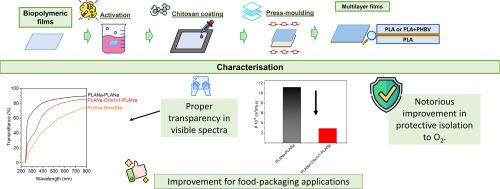壳聚糖薄阻隔层对聚乳酸和聚3-羟基丁酸-co-3-羟基戊酸多层膜透氧性和光学性能的影响
IF 6.5
Q1 CHEMISTRY, APPLIED
Carbohydrate Polymer Technologies and Applications
Pub Date : 2025-06-25
DOI:10.1016/j.carpta.2025.100918
引用次数: 0
摘要
聚(3-羟基丁酸酯-co-3-羟基戊酸酯)(PHBV)和聚乳酸(PLA)由于其良好的机械和光学性能以及良好的可持续性,在食品包装工业中具有广阔的应用前景。然而,一些性能,如氧气渗透性需要改进。在这项工作中,我们制备并测试了PLA和PLA与PHBV共混物的双层膜,并添加了一层薄薄的壳聚糖(CH),以降低氧透过率(OTR)而不影响光学性能。在这些材料中,亲水性CH和疏水性生物聚合物之间的相容性差是一个严重的障碍,因为它导致层之间的粘附力弱。在室温条件下,不同时间的NaOH水溶液对疏水聚合物表面进行活化,提高了聚合物的亲水性。考虑到生物聚酯可以进行NaOH催化水解降解,采用FT-IR光谱、扫描电镜(FE-SEM)、显微硬度和接触角测量等方法研究了NaOH处理对聚合物结构的影响。PHBV的使用和薄薄的CH层的使用都会导致O2渗透率的显著降低。在内层CH的情况下,这种下降更大,这也降低了紫外线透过率,但没有明显影响薄膜的透明度。本文章由计算机程序翻译,如有差异,请以英文原文为准。

Effects of chitosan thin barrier layers on the oxygen permeability and optical properties of poly(lactic acid) and poly(3-hydroxybutyrate-co-3-hydroxyvalerate) multilayers
Poly(3-hydroxybutyrate-co-3-hydroxyvalerate) (PHBV) and poly(lactic acid) (PLA) are highly promising biobased and biodegradable polymers in food packaging industry due to their mechanical and optical properties, and improved sustainability. Nevertheless, some properties like O2 permeability need improvement. In this work we have prepared and tested bilayers from PLA and blends of PLA and PHBV, with an additional thin layer of chitosan (CH) to reduce the oxygen transmission rate (OTR) without compromising optical properties. In these materials, the poor compatibility between hydrophilic CH and hydrophobic biopolymers is a serious handicap, as it leads to weak adhesion between the layers. The hydrophobic polymer surfaces were activated with aqueous NaOH at room temperature for different times, which increased hydrophilic character. Considering that biopolyesters can undergo NaOH-catalised hydrolytic degradation, the effect of NaOH treatment on the structure of the polymers was also studied by using FT-IR spectroscopy, scanning electron microscopy (FE-SEM), microhardness and contact angle measurements. Both the use of PHBV and a thin layer of CH lead to significant decreases in O2 permeability. The decrease is greater in the case of the inner CH layer, which also reduces UV transmittance without significantly affecting the transparency of the film.
求助全文
通过发布文献求助,成功后即可免费获取论文全文。
去求助

 求助内容:
求助内容: 应助结果提醒方式:
应助结果提醒方式:


